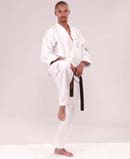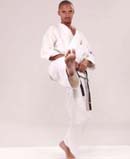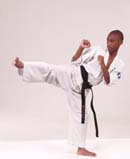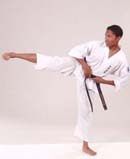Kihon-Keri – Ashihara Karate International – Kaicho Hoosain Narker Sabaki Fighting Karate
    Click on the drop down menu of the left to see a greater explanation of the above kicks. Check your technique from the bottom up and from the point closest to your centre of gravity Click on the drop down menu of the left to see a greater explanation of the above kicks. Check your technique from the bottom up and from the point closest to your centre of gravityDuring basic practice, contract each part of the kick as much as possible to create tension, which is released through the turning motion of the kick. If you don’t turn your hips enough, the technique will lack of power and you’ll lose balance. Kicks depend on flexibility. Stretching the hip joint (‘the splits’) is therefore a vital part of training. High kicks are higher and sharper if you have a good turn and stretch in the hip joint. Keep hold of your belt while practising kicks! If your hands are free, use them to stabilise yourself, and never notice how really bad your balance is. It is very difficult to correct bad balance once it becomes a habit, so if you can balance without using your hands, then you’ll easily be able to punch and guard yourself as you kick in a real fight. For those who have a problem with balance, first master both the kicking motion and the twisting action of the hips while holding onto a hand rail, and gradually develop a sense of balance. Make sure: your pivot leg is stable. your pivot leg knee is not pointing outwards. weight shift is smooth and fast. the twist at the hips is smooth and sharp. your hips are flexible. your shoulders aren’t tense there’s enough spring in your knees and hips. power is concentrated at the point of impact. you don’t follow through too much. you are training out of the front stance. you extend your pivot leg in the direction of impact. Let the leading edge of your attack run freely to its target. It’s helpful here to train to kick without turning your supporting leg, using the spring and turn in hips. the kicking leg and the knee of the supporting leg instead. |
